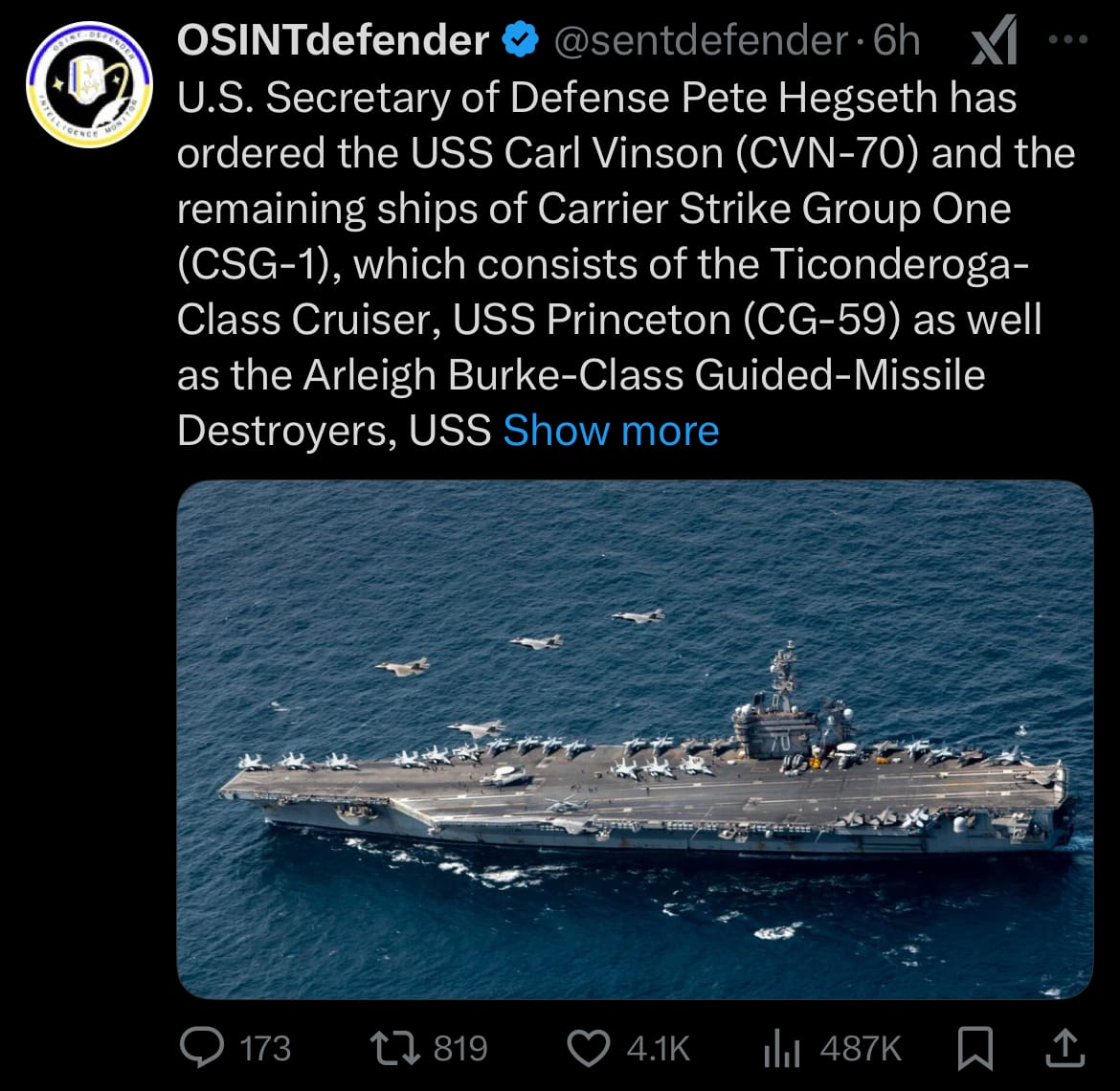Saturday☕️

Economics & Markets:
- Yesterday’s U.S. stock market:

- Yesterday’s commodity market:

- Yesterday’s crypto market:

Geopolitics & Military Activity:
- Following the collapse of a two-month ceasefire that began in January 2025, Israel resumed airstrikes across the Gaza Strip, targeting Hamas infrastructure and leadership. The ceasefire, which facilitated the release of hostages and prisoners, faltered when negotiations stalled over extending the truce into a second phase aimed at ending the war permanently. Israeli Prime Minister Benjamin Netanyahu and Defense Minister Israel Katz ordered the escalation, citing Hamas’s refusal to release additional hostages as the primary reason. The renewed campaign, starting around March 17, 2025, marked a return to intense military operations, with the Israeli Air Force striking dozens of targets, including command centers and weapons stockpiles, across the region.

- Over the past few days, from March 17 to March 21, 2025, the airstrikes in Gaza have intensified significantly, with reports indicating over 400 Palestinian deaths and hundreds injured, according to Gaza health authorities. The bombardment has spanned northern, central, and southern Gaza, with notable ground operations resuming in areas like the Netzarim Corridor. Israel claims these actions are necessary to pressure Hamas and prevent its rearmament, while Palestinian officials and Hamas argue the strikes aim to displace civilians and deepen the humanitarian crisis. Simultaneously, Israel has expanded its military focus, conducting airstrikes on Syrian targets linked to Iranian-backed militias and weapon transfers, aiming to curb regional threats amid the ongoing Gaza conflict.

- Yesterday, March 21, 2025, U.S. Secretary of Defense Pete Hegseth ordered the USS Carl Vinson and Carrier Strike Group One (CSG-1) to the Middle East, joining the USS Harry S. Truman Carrier Strike Group (CSG-75) in the northern Red Sea. This deployment strengthens U.S. naval presence amid rising tensions across the region, including Israel’s intensified airstrikes in Gaza and Syria, Syria’s ongoing power struggles post-Assad, and Yemen’s Houthi attacks on shipping lanes. Concurrently, the U.S. has escalated its airstrike campaign against Houthi targets in Yemen, focusing on degrading their missile and drone capabilities after increased attacks on Red Sea vessels. The conflicts, while centered on Israel’s actions, intersect with broader regional instability.
Environment & Weather:
- Yesterday, March 21, 2025, a forest fire in Sancheong County, South Korea, triggered a Level 3 alert. The blaze has burned 120 hectares, leading to the evacuation of 115 residents. Winds exceeding 15 mph have worsened the fire’s spread. Over 500 personnel, supported by over 20 helicopters and fire trucks, are working to contain it.

- Sancheong County, in South Gyeongsang Province, is a rural, mountainous area with a population of about 35,000. Known for its forests and ginseng farming, the region faces heightened wildfire risks in spring due to dry conditions and strong winds. No casualties have been reported, and efforts continue to protect residents and limit damage.


Space:
- Yesterday, March 21, 2025, SpaceX launched its Falcon 9 rocket from Vandenberg Space Force Base, California, for the NROL-57 mission, deploying classified satellites for the U.S. National Reconnaissance Office (NRO). This fifth launch in a series for the NRO’s proliferated architecture constellation, built by SpaceX and Northrop Grumman, enhances reconnaissance capabilities. The Falcon 9 booster, B1088, on its third flight, landed at Landing Zone 4 after supporting prior missions like NROL-126 and Transporter-12, showcasing SpaceX’s reusable rocket technology and role in national security space efforts.

- Yesterday, March 21, 2025, China launched a Long March 2D rocket from Jiuquan Satellite Launch Center. It carried Yunyao-1 07-12, a group of six weather satellites for a future 55-60 satellite network, and Zhongke-06 and Zhongke-07, two remote sensing satellites for Earth observation. The launch took place at Site 95A, boosting China’s space efforts. Jiuquan, located in the Gobi Desert across Inner Mongolia and Gansu, is China’s oldest spaceport, opened in 1958. Covering 2,800 square kilometers, it launched China’s first satellite in 1970 and remains vital for satellite and crewed missions, supporting a busy 2025 schedule.
Science & Technology:
- Yesterday, March 21, 2025, President Donald Trump announced Boeing’s contract to build the F-47, the U.S. Air Force’s first sixth-generation fighter jet. This stealth air superiority fighter, meant to replace the F-22 Raptor, has advanced features like supercruise speeds over Mach 2, advanced stealth, and cutting-edge sensors. Developed by Boeing’s Phantom Works, the F-47’s tailless, high-dihedral wing design comes from over five years of secret testing. It’s designed to counter threats from nations like China and Russia and is considered the most advanced fighter yet.

- The F-47 leads the Next Generation Air Dominance (NGAD) program, started in 2014 to keep U.S. air superiority. NGAD pairs the F-47 with unmanned drones, advanced engines like GE’s XA102 or Pratt & Whitney’s XA103, and networked systems for battlefield coordination. Boeing won the $20 billion contract over Lockheed Martin, a decision pushed by Trump after a 2024 pause. The U.S. currently has the world’s most powerful air force, with assets like the F-35, F-22, B-21 Raider, and now the F-47, leading in both numbers and technology.
Statistic:
- Public companies by largest number of employees:
- 🇺🇸 Walmart: 2,100,000
- 🇺🇸 Amazon: 1,551,000
- 🇹🇼 Foxconn (Hon Hai Precision): 826,608
- 🇮🇪 Accenture: 774,000
- 🇩🇪 Volkswagen: 656,134
- 🇮🇳 Tata Consultancy Services: 601,546
- 🇩🇪 DHL Group (Deutsche Post): 594,879
- 🇨🇳 BYD: 570,100
- 🇬🇧 Compass Group: 550,000
- 🇨🇳 Jingdong Mall (JD): 517,124
- 🇺🇸 United Parcel Service (UPS): 500,000
- 🇷🇺 Gazprom: 468,000
- 🇺🇸 Home Depot: 465,000
- 🇨🇳 JD Logistics: 457,015
- 🇨🇳 Agricultural Bank of China: 452,258
- 🇨🇳 China Mobile: 451,830
- 🇭🇰 Jardine Matheson: 443,000
- 🇺🇸 Concentrix: 440,000
- 🇺🇸 UnitedHealth: 440,000
- 🇨🇳 ICBC: 419,252
- 🇺🇸 Target: 415,000
- 🇺🇸 Kroger: 414,000
- 🇺🇸 Marriott International: 411,000
- 🇳🇱 Ahold Delhaize: 400,000
- 🇨🇳 Yum China: 400,000
History:
- The history of fighter jets traces back to World War I, when biplanes like Britain’s Sopwith Camel and Germany’s Fokker Dr.I, armed with machine guns, turned reconnaissance aircraft into dogfighters, establishing air combat’s role in war. World War II accelerated development with piston-engine monoplanes like the American P-51 Mustang, British Spitfire, and German Messerschmitt Bf 109, offering greater speed and firepower. The jet era began in 1944 with Germany’s Me 262, the first operational jet fighter, followed by the Cold War’s first-generation jets like the U.S. F-86 Sabre and Soviet MiG-15, which debuted in Korea with swept wings and jet engines. Early players—Fokker, Supermarine, North American Aviation, and Mikoyan-Gurevich—pushed boundaries, while second-generation jets like France’s Mirage III added supersonic speed, enhancing battlefield reach and impact.
- By the 1960s, third-generation fighters like the U.S. F-4 Phantom and Soviet MiG-23 introduced radar-guided missiles and multirole capabilities, shifting tactics toward versatility, as seen in Vietnam and Middle East conflicts. The 1970s brought fourth-generation jets—the American F-15 Eagle, Soviet Su-27, and European Tornado—blending agility with advanced avionics, while the fifth generation, like the U.S. F-22, Russian Su-57, and Chinese J-20, prioritized stealth and sensor fusion from the 2000s onward. Each step improved precision, range, and survivability, evolving combat from close-range duels to networked, long-distance engagements. By March 21, 2025, Boeing’s F-47 emerged as a sixth-generation concept, reflecting a global legacy of innovation from wood-and-canvas origins to today’s high-tech platforms, driven by a century of rivalry and technological leaps across nations.
Image of the day:

Thanks for reading!
Earth is complicated, we make it simple.
Click image to view the Earth Intelligence System:



Support/Suggestions Email:
earthintelligence@earthintel.news




